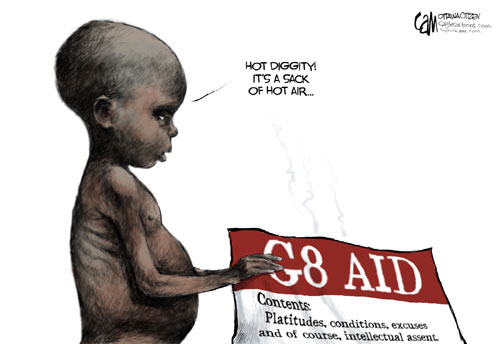Rock and movie stars also hopped onto the aid bandwagon. Back in 1985, there was “Live Aid” intended to save the famine victims in Ethiopia and a “Special Session on Africa” held by the United Nations to boost aid to Africa. Nothing more was heard of them in subsequent years. A year later in 1986, the United Nations announced a Program of Action for African Recovery and Development (PAAERD).
Five years later came the United Nations New Agenda for African Development (UNNADAF) in 1991. Then in March 1996, the U.N. launched a $25 billion Special Initiative for Africa. They all fizzled.In September 2005, the plight of Africa again took center-stage at a U.N. conference with clockwork precision. The international community mounted a campaign to boost foreign aid to Africa. The U.N. called on rich countries to increase their foreign aid to 0.7 percent of GDP by 2015.
In Feb 2005, former South African president, Nelson Mandela, urged rich countries to back Britain’s call for a doubling of international aid to the world’s poorest countries and act immediately on canceling their debts. Comparing poverty with slavery at a rally in central London’s Trafalgar Square, Mandela described the poor as “imprisoned, enslaved and in chains. Trapped in the prison of poverty, it is time to set them free” (The Washington Times, Feb 4, 2005; p.A15).
Tony Blair of Britain declared 2005 as the “Year of Africa” and set up a Commission on Africa, co-chaired by Ethiopia’s Prime Minister, Meles Zenawi, to raise US$50 billion (euro38 billion) a year on the international capital markets, which Prime Minister Tony Blair made the centerpiece in Britain’s presidency of the G-8 industrialized nations that met in Gleneagles, Scotland in July 2005. The G-8 leaders also agreed to write off $40 billion of poor nations’ debts and pledged to double aid to Africa to $50 billion by 2010. Two years later, only 10 percent of those pledges have been fulfilled. Germany fell short of Gerhard Schroeder’s commitment by 700 million euros or $1.14 billion in aid to Africa. Chancellor Angela Merkel has promised to honor Germany’s remaining commitment but has not done so.
In 2005, the G-8 leaders were not all in agreement. John Taylor, the U.S. Treasury Department’s undersecretary for international affairs in the George Bush administration, rejected the British plan as incompatible with U.S. budget rules. Washington would rather work through its own foreign aid program — the Millennium Challenge Accounts (MCAs), helping poor countries through grants instead of loans in the future. Three other competing proposals were floated. France proposed an international tax on financial transactions, or items such as plane tickets while Japan favored a US$200 million fund to nurture private sector companies in Africa to improve the continent’s investment climate and credit rating. In Jan 2005, the United Nations released its own report, co-authored by Columbia University economist, Jeffrey Sachs, calling on rich countries to increase their foreign aid to 0.7 percent of GDP by 2015.
Since 1960, the West has pumped more than $700 billion into Africa with nothing to show for except collapsed states, a multitude of black elephants, decayed institutions and crumpled infrastructure.

